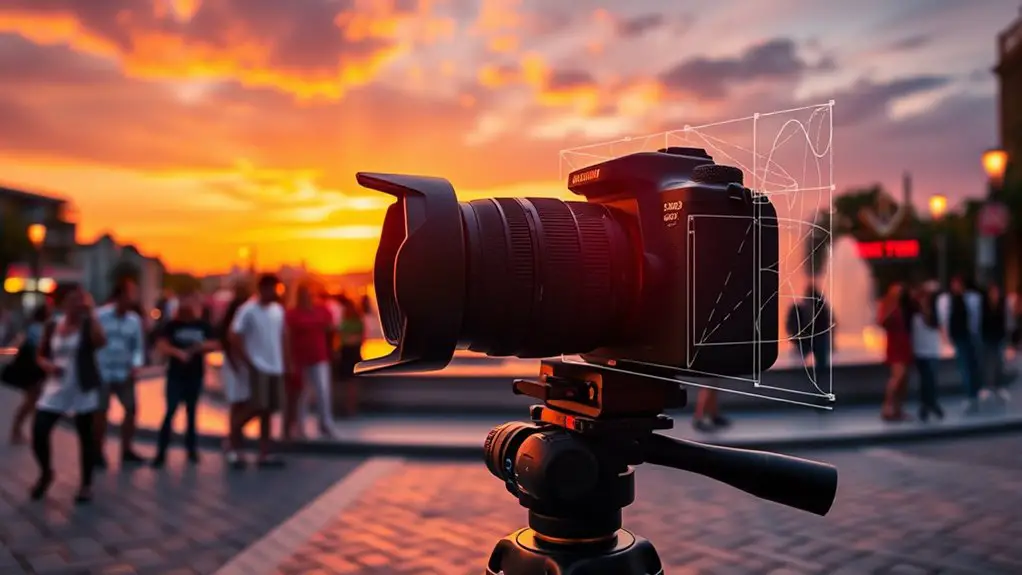AI-powered scene detection in modern cameras uses machine learning to analyze images in real-time. It breaks down photos into key elements, like light and color, allowing the camera to identify subjects and backgrounds efficiently. This technology predicts ideal settings for exposure, focus, and white balance based on the scene. By automating adjustments, you can concentrate on your creative vision. If you're curious about scene modes and future trends, there's more to explore!
Understanding AI and Scene Detection Technology
As cameras evolve, understanding AI and scene detection technology becomes essential for maximizing their potential. By leveraging machine learning, modern cameras can analyze images in real-time, improving the way you capture moments. These systems utilize advanced image processing techniques to identify various elements within a scene, allowing for more accurate adjustments in exposure, focus, and color balance.
When you grasp how AI interprets visual data, you'll discover new creative possibilities. The technology learns from vast datasets, continuously improving its ability to recognize patterns and objects. This means your camera becomes more intuitive, adapting to your style while ensuring high-quality results. Embracing these innovations not only enhances your photography but also grants you the freedom to explore your artistic vision without technical limitations.
How Scene Detection Analyzes Elements in a Photograph
The way scene detection analyzes elements in a photograph is a fascinating process that combines advanced algorithms and real-time data processing. When you take a shot, the camera performs image analysis by breaking down the scene into various components—like light, color, and shapes. It identifies subjects, backgrounds, and even textures, evaluating their relationships within the frame. This meticulous examination helps the camera understand photographic composition, ensuring that elements are balanced and harmonious. By leveraging deep learning techniques, scene detection can predict the ideal settings for exposure, focus, and white balance, tailored to the specific scene. This level of analysis empowers you to capture stunning images effortlessly, allowing you to focus more on your creative vision while the technology enhances your photographic experience.
The Benefits of AI-Powered Scene Detection for Photographers
While many photographers spend years honing their skills, AI-powered scene detection can greatly enhance your shooting experience, making it easier to capture exceptional images. This technology analyzes the scene in real-time, allowing your camera to make automated adjustments that improve exposure, focus, and color balance. You can focus on creative composition without worrying about manual settings, which can be a game-changer in dynamic environments. With AI handling these technical aspects, you'll have more freedom to experiment and express your unique vision. Additionally, AI can recognize various scenes, optimizing your camera's performance for landscapes, portraits, or low-light conditions. Embracing AI-powered scene detection lets you elevate your photography while freeing you to focus on what you love most—creating stunning images.
Common Scene Modes and Their Applications
With AI-powered scene detection enhancing your photography, understanding common scene modes can further optimize your camera's performance. Each mode is crafted for specific scenarios, helping you capture stunning images effortlessly.
| Scene Mode | Application |
|---|---|
| Landscape Mode | Perfect for wide vistas and natural beauty |
| Portrait Mode | Focuses on subjects with blurred backgrounds |
| Night Mode | Enhances low-light photography and details |
| Macro Mode | Ideal for close-ups of tiny subjects |
| Sports Mode | Captures fast-moving action with clarity |
| Sunset Mode | Balances colors for breathtaking twilight shots |
Future Trends in AI-Enhanced Photography
As technology continues to evolve, the future of AI-enhanced photography promises to revolutionize how you capture and edit images. Imagine using smart composition tools that analyze your scene and suggest ideal framing in real-time, ensuring your photos are consistently enchanting. AI will also streamline the editing process through automated editing features, allowing you to achieve professional results without the steep learning curve. These advancements will empower you to focus on creativity rather than technicalities, giving you the freedom to explore your artistic vision. Additionally, AI will learn your personal style, adapting its suggestions to match your tastes over time. Ultimately, the integration of AI in photography will make it more accessible, enabling everyone to create stunning visuals effortlessly.
Frequently Asked Questions
How Does Scene Detection Affect Battery Life in Cameras?
You'd think scene detection drains battery life, but ironically, it actually enhances processing efficiency. By optimizing settings, cameras conserve energy, resulting in lower battery consumption and longer shooting sessions, giving you the freedom to capture more.
Can Scene Detection Work in Low-Light Conditions?
Yes, scene detection can work in low-light conditions, enhancing image quality by adjusting settings for best low light performance. This technology helps you capture clearer, more vibrant photos, even when lighting isn't ideal.
Is Scene Detection Available on All Camera Brands?
Imagine capturing a sunset with your favorite camera. Scene detection isn't universally available; brand differences mean some models excel while others lack compatibility. Always check specifications to confirm your camera supports this feature for best results.
Does Scene Detection Require Internet Access to Function?
Scene detection doesn't always require internet access; many cameras utilize offline functionality. They rely on advanced camera processing to analyze scenes in real-time, allowing you to capture stunning images without being tethered to a network.
How Does Scene Detection Improve Over Time With Updates?
Scene detection improves over time through algorithm improvements and user feedback. As cameras learn from diverse usage, they adapt, enhancing accuracy and responsiveness, allowing you to capture better images with less effort and more creativity.

